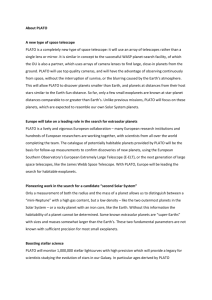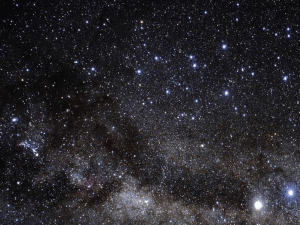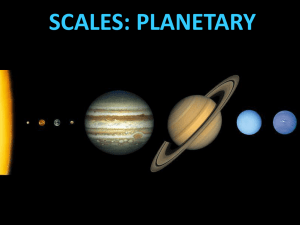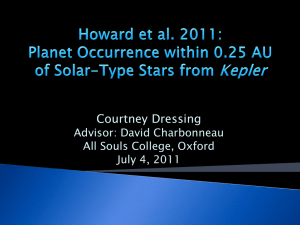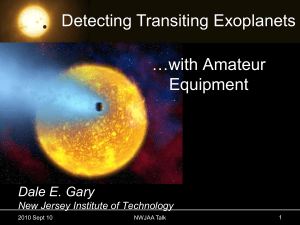The search for exoplanets
advertisement
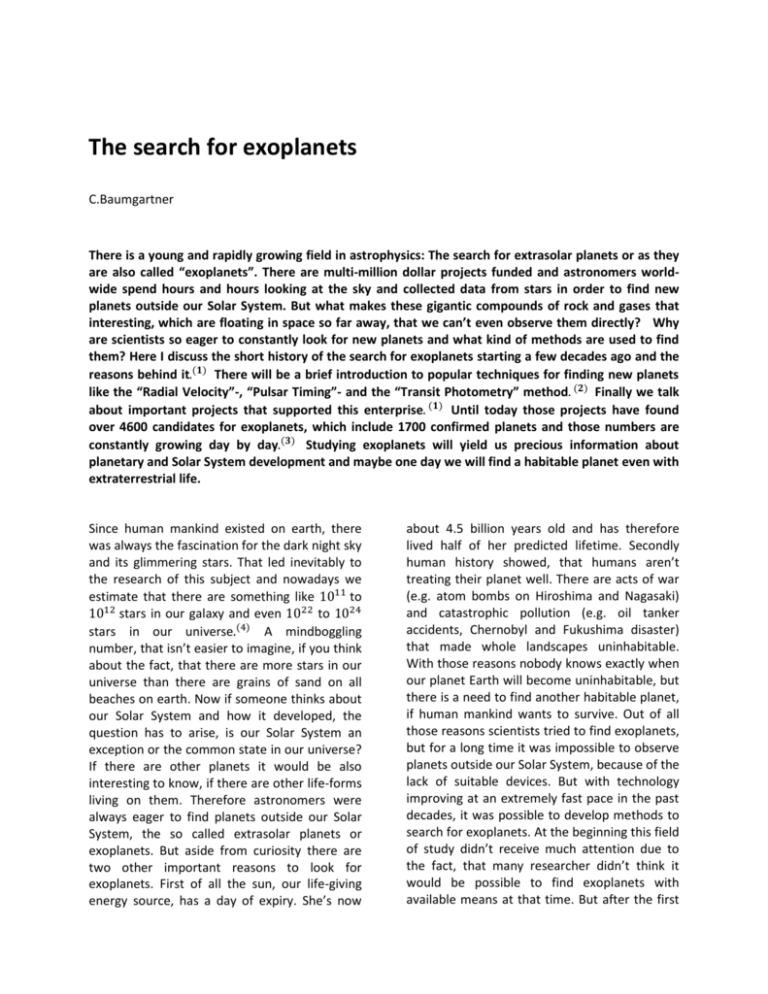
The search for exoplanets C.Baumgartner There is a young and rapidly growing field in astrophysics: The search for extrasolar planets or as they are also called “exoplanets”. There are multi-million dollar projects funded and astronomers worldwide spend hours and hours looking at the sky and collected data from stars in order to find new planets outside our Solar System. But what makes these gigantic compounds of rock and gases that interesting, which are floating in space so far away, that we can’t even observe them directly? Why are scientists so eager to constantly look for new planets and what kind of methods are used to find them? Here I discuss the short history of the search for exoplanets starting a few decades ago and the reasons behind it.(𝟏) There will be a brief introduction to popular techniques for finding new planets like the “Radial Velocity”-, “Pulsar Timing”- and the “Transit Photometry” method. (𝟐) Finally we talk about important projects that supported this enterprise. (𝟏) Until today those projects have found over 4600 candidates for exoplanets, which include 1700 confirmed planets and those numbers are constantly growing day by day.(𝟑) Studying exoplanets will yield us precious information about planetary and Solar System development and maybe one day we will find a habitable planet even with extraterrestrial life. Since human mankind existed on earth, there was always the fascination for the dark night sky and its glimmering stars. That led inevitably to the research of this subject and nowadays we estimate that there are something like 1011 to 1012 stars in our galaxy and even 1022 to 1024 stars in our universe.(4) A mindboggling number, that isn’t easier to imagine, if you think about the fact, that there are more stars in our universe than there are grains of sand on all beaches on earth. Now if someone thinks about our Solar System and how it developed, the question has to arise, is our Solar System an exception or the common state in our universe? If there are other planets it would be also interesting to know, if there are other life-forms living on them. Therefore astronomers were always eager to find planets outside our Solar System, the so called extrasolar planets or exoplanets. But aside from curiosity there are two other important reasons to look for exoplanets. First of all the sun, our life-giving energy source, has a day of expiry. She’s now about 4.5 billion years old and has therefore lived half of her predicted lifetime. Secondly human history showed, that humans aren’t treating their planet well. There are acts of war (e.g. atom bombs on Hiroshima and Nagasaki) and catastrophic pollution (e.g. oil tanker accidents, Chernobyl and Fukushima disaster) that made whole landscapes uninhabitable. With those reasons nobody knows exactly when our planet Earth will become uninhabitable, but there is a need to find another habitable planet, if human mankind wants to survive. Out of all those reasons scientists tried to find exoplanets, but for a long time it was impossible to observe planets outside our Solar System, because of the lack of suitable devices. But with technology improving at an extremely fast pace in the past decades, it was possible to develop methods to search for exoplanets. At the beginning this field of study didn’t receive much attention due to the fact, that many researcher didn’t think it would be possible to find exoplanets with available means at that time. But after the first few confirmed extra-solar planets were found, the field started to flourish and many multimillion dollar projects were funded to find more. In this paper I discuss the history of the search for exoplanets and explain some of the methods used to find them. Finally I present some of the projects that were funded. Since the 19th century many scientists claimed to have found new planets outside our solar system. First reports occurred in 1855 by Captain W.S. Jacob from the East Indian Observatory in Madras. He thought, that he had found signs of an exoplanet around the doublestar 70 Ophiuchi. But like many others to follow, it could not be proven. In 1963 Peter von de Kamp, director of the Sproul-observatory at the Swarthmore College in Philadelphia published papers about a new found planet around the so called Barnards-Star, but after further research it was assumed that there was a failure in measurements. Starting in the 1980s Gordon Walker of the University of British Columbia observed 29 stars similar to our sun at the Canada France Hawaii Telescope (CFHT) for about 12 years. Due to only 6 nights per year observation-time it was no surprise, that they weren’t able to find any signs of extrasolar planets. It’s important to note that in 1988 they found signs of an exoplanet in the double-star system Gamma Cephei. Because of many sceptics and their own uncertainty, they withdraw their claim on having found the first exoplanet. Other researches confirmed their discovery in 2003. Later on another problem became apparent. Theorists proclaimed, that our solar-system with high density solid planets on the inner orbits and the low density gas giants further away from the sun should be the common state in our universe. That’s also a reason, why at first astronomers looked for similar behavior of other solar-systems and therefore weren’t especially successful. Things started to change in 1992. Aleksander Wolszczan and Dale Frail from the Pennsylvania State University found the first confirmed exoplanet around pulsar PSR B1257+12 in the constellation Virgo. Not quite what they were looking for, because a planet next to a pulsar, which constantly emits deadly radiation doesn’t support life. But it was the first success of finding a planet outside our solar system. In the following year other planets around pulsars were discovered. The discovery of exoplanets around ‘living’ stars started in 1990. The Swiss researcher Michel Mayor from the University of Geneva worked on a high-precision spectrometry system called ÈLODIE. After its completion it was installed at the Observatory de Haute Provence. He examined about 142 stars, and on the 5th of July in 1995 he was able to find the first exoplanet around the star 51 Pegasi. It has half of the mass of Jupiter and circuits his star in 4.2 days. From then on the discovery of many more planets followed, but none of them was earth-sized and orbiting his star in its habitable zone. On April 17th 2014 NASA’s Kepler-telescope discovered the first Earth-size planet Kepler186f in a habitable zone, which is also accompanied by four other planets. It orbits its star (a red dwarf) once every 130 days and receives one-third of the energy that the earth gets from the sun. Not much is known about its mass or composition, but it is thought that is very likely to be rocky. Until today over 4600 candidates exoplanets are found, which include 1700 confirmed planets and those numbers are constantly growing day by day.(3) After all that history the question arises, how astronomers look for new exoplanets and which methods they are using. Because exoplanets are extremely faint, all methods are indirect. That means, that not the planets themselves are observed but their influence on the light emitted by the star it orbits. To improve research in that field, they needed to develop special techniques and auxiliary means that improved the researchers’ perception. There was also a demand for a device that helps collecting and evaluating large amounts of data. The first special techniques were developed in the 1950 but the necessary auxiliary devices weren’t available until the 1990s. Also the computer played a special role in collecting and evaluating data. Concerning devices, a giant step in improving precision was achieved, when “Adaptive Optics” were invented. They were used to reduce atmospheric wave-front distortions of the observed light. This happens with the help of sensors measuring atmospheric turbulences and then sending correction-signals to deformable mirrors in telecopes. Although the idea was invented by Horace W. Babcock in 1953 it took until the 1990s that “Adaptive Optics” found their way into civil observatories. Another important invention were CCDs (Charge Couple Devices) in 1969. Those image sensors were able to convert incoming photons into electron charges, which could be used to directly save the observed image and to get more accurate data. One of the first methods, the so called ‘Radial Velocity’-method, was invented by Otto von Struve in the 1950s.(5) According to theory planets orbiting a star have gravitational influence on the stars movement. By observing the emitted light of the star and taking the Doppler shift into consideration the amplitude K of its radial velocity variations can be measured: 1 𝐾= 2 𝜋 𝐺 3 𝑀𝑝 sin 𝑖 1 (𝑃 ) 2 2 √1−𝑒 𝑜𝑟𝑏 (𝑀𝑠 +𝑀𝑝 )3 (Eq.1) where 𝑃𝑜𝑟𝑏 is the orbital period, 𝑖 the angle between the normal to the orbital plane and the line of sight, and e is the orbit’s eccentricity. This is the most successful version developed until today. But a downside of this technique is that it is most sensitive to massive planets and planets in short-period orbits. Precise measurements also require a large amount of spectral lines, which are not provided by hot stars (spectral class A, B, O). The first confirmed detections of extrasolar planets were provided by ‘Pulsar Timing’.(6) The first pulsar PSR B1919+21 was observed on November 28 in 1967, and with this observation the idea to use their periodic emitted radio waves in order to detect exoplanets evolved. Those emissions are in most cases extremely periodic but may vary in measurements, if the distance between pulsar and telescope changes in a non-linear fashion. Such variations are caused by the Earth’s motion around the Sun and Earth’s rotation. The influence of this motion can be calculated and subtracted from the data. If there are still periodic variations in the reduced data, that might be an indication for exoplanets around this pulsar. Another popular technique is ‘Transit Photometry’. If a planet lies on approximately the same orbital plane like the earth does to the sun, the transit of that planet can be observed from Earth. This periodic transits cause variations in the star’s brightness. If we are neglecting variations of brightness across the stellar disk, the fractional decrease in luminosity L is given by: 𝛥𝐿 𝐿 𝑟𝑃 2 = ( ) 𝑟 𝑆 (Eq.2) One big advantage is, that planets found with the ‘Transit Photometry’ method are observable via ‘Radial Velocity’ as well. With mass and radius a density can be calculated. Another important fact is, if the planet has some kind of atmosphere, it absorbs parts of the light spectrum of its star. Therefore conclusions on the composition of the exoplanets atmosphere can be drawn. The technique of ‘Transit Photometry’ is also the predominant method used in different space projects. The first mission designed to search exclusively for exoplanets by using this method was the CoRoT-Telescope launched on December 27 in 2006 as a cooperation of the European (ESA) and the French (CNES) space associations. CoRoT is an abbreviation for ‘Convection Rotation and planetary transits’. It observed 12 000 stars simultaneously and searched in the constellations Monoceros (unicorn), Aquila (eagle), Scutum (shield) and Serpens (snake). In spring 2007 it found its first exoplanet, named CoRoT – 1b. It is 1500 lightyears away, has 1.3 times the mass of Jupiter and orbits its sun in 1.5 days. The telescope was supposed to work until March 2013, but due to a computer failure the program had to be shut down in November 2012. During its lifetime CoRoT discovered 15 planets, which was less than expected. Another space program was launched by the NASA on March 7, 2009. It is called the KeplerTelescope.(7) It also searches exclusively for extrasolar planets with the transit method. It’s monitoring about 100.000 stars in the constellation Cygnus (swan). Special about Kepler is, that it isn’t in an orbit around earth but in a heliocentric one to get rid of earth’s influence on observations. Until today Kepler has found about 410 planets and on April 27th 2014 it found the first Earth-like planet in a habitable zone.(8) As a conclusion the search for exoplanets is a young field of astronomy that still has plenty to learn. Before the discovery of extrasolar planets, models of planetary growth suggested that most single solar-type stars possess planetary systems that are grossly similar to our Solar System. But after many observations nature proofed us wrong and since exoplanets are so far away and appear very faintly next to their stars, there will always be the need to improve our technological devices in order to be able to spot more of them. With the discovery of every new planet we learn more about the development of solar systems throughout the universe and maybe someday we find a planet other than our planet Earth that supports live. Sources: (1) S.Piper, Exoplaneten: Die Suche nach einer neuen Erde (Springer-Verlag, Berlin Heidelberg, 2014) (2) J.J.Lissauer, I.Pater, Fundamental Planetary Science (Cambridge University Press, New York, 2013) (3) NASA Jet Propulsion Laboratory, http://planetquest.jpl.nasa.gov/news/158 (29.04.2014) (4) J.Bennet et al, Astronomie: Die kosmische Perspektive (Pearson Studium, Munich, 2010) (5) O.Struve, The Observatory 72, pp. 199-200 (1952) (6) J.M.Cordes, ASP Conference Series 36, pp.4260 (1993) (7) D.G.Koch et al, The Astrophysical Journal Letters 713, L79 (2010) (8) E.V.Quintana et al., Science 344, pp.277-280 (2014) Da aktuelle Daten hierzu schwer zu finden sind, habe ich bei (3) als Quelle eine Internetseite verwendet, da ich annehme, dass die NASA als Quelle vertrauenswürdig genug erscheint (auch wenn man im Normalfall auf Internetquellen verzichten sollte). Ich habe im Folgenden zu findende Kopien der entsprechenden Seiten gemacht und das Datum notiert, an dem ich die Informationen dort entnommen habe, damit man im Notfall die Quelle nachverfolgen könnte. (3) Nasa Jet Propulsion Laboratory, http://planetquest.jpl.nasa.gov/news/158 (29.04.2014) Part 1 Part 2 Part 3

